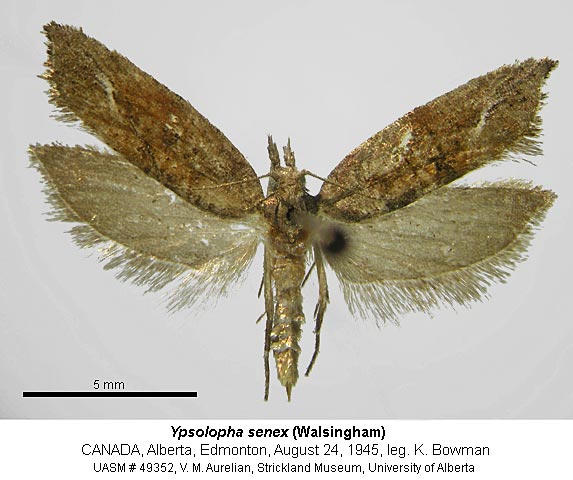Species Details
Ypsolopha senex
University of Alberta E.H. Strickland Entomological Museum Read more about this collection »
SeasonalityAdults fly from June to September, with most specimens being collected in July and August. Specimens attracted to light.
IdentificationAdults are of a uniform, drab colour. Head brownish, antennae brown, labial palpi porrect, heavily scaled, brown. Thorax brownish, metathorax with some rusty-coloured scales. Forewings with pointed apices. Dorsal surface of forewings dirty brown with various pale markings and spots. Discal region with an oblique, cream-coloured line that is slightly curved. Hindwings are of a uniform light grey. Ventral wing surfaces, legs and abdomen light grey. It can be distinguished from other microlepidoptera by its slightly hooked forewings, broad hindwings and porrect labial palpi. In Alberta this species can be confused with a pale morph of Ypsolopha flavistrigella, however the latter differs from Y. senex by a uniform grey colouring of forewings and absence of the whitish oblique line in the discal region. It can also be confused with Y. dorsimaculella, however dorsimaculella has two well-defined dark-brown spots on the internal margin of forewings, no hooked forewings and no whitish, oblique marking in the discal region of forewings.
Scientific Name
Ypsolopha senex
Habitat
A wide variety of habitats, from riparian ecosystems to mixed wood forest and alpine tundra, wherever its host plant occurs.
Seasonality
Adults fly from June to September, with most specimens being collected in July and August. Specimens attracted to light.
Identification
Adults are of a uniform, drab colour. Head brownish, antennae brown, labial palpi porrect, heavily scaled, brown. Thorax brownish, metathorax with some rusty-coloured scales. Forewings with pointed apices. Dorsal…
Adults are of a uniform, drab colour. Head brownish, antennae brown, labial palpi porrect, heavily scaled, brown. Thorax brownish, metathorax with some rusty-coloured scales. Forewings with pointed apices. Dorsal surface of forewings dirty brown with various pale markings and spots. Discal region with an oblique, cream-coloured line that is slightly curved. Hindwings are of a uniform light grey. Ventral wing surfaces, legs and abdomen light grey. It can be distinguished from other microlepidoptera by its slightly hooked forewings, broad hindwings and porrect labial palpi. In Alberta this species can be confused with a pale morph of Ypsolopha flavistrigella, however the latter differs from Y. senex by a uniform grey colouring of forewings and absence of the whitish oblique line in the discal region. It can also be confused with Y. dorsimaculella, however dorsimaculella has two well-defined dark-brown spots on the internal margin of forewings, no hooked forewings and no whitish, oblique marking in the discal region of forewings.
Life History
Larva uniformly green with no distinct markings, head capsule green. Feeding occurs in a loose web. Like for most North American Ypsolopha species, the life cycle is not well understood, but it most likely has one…
Larva uniformly green with no distinct markings, head capsule green. Feeding occurs in a loose web. Like for most North American Ypsolopha species, the life cycle is not well understood, but it most likely has one generation per year (Ives & Wong, 1988). Pupation takes place in silken cocoons of a tubular shape.
Conservation
Not of concern. A widespread native species of no economic importance, occupying a great variety of habitats.
Diet Info
Willow leaves (Salix spp.) (Ives & Wong 1988).
Range
A very common species occurring throughout North America. In Canada it occurs in most provinces, from B.C. (Scudder and Cannings 2007) and Alberta (Bowman 1951) to Manitoba (Ives & Wong 1988). Since willows are…
A very common species occurring throughout North America. In Canada it occurs in most provinces, from B.C. (Scudder and Cannings 2007) and Alberta (Bowman 1951) to Manitoba (Ives & Wong 1988). Since willows are widespread in North America including the Canadian subarctic (Begin & Payette 1991) it is very likely Y. senex has a much larger distribution than currently known. This species is present in most of the continental U.S.
References
Author
Bowman, K.
Title
An annotated list of the Lepidoptera of Alberta.
Publication Date
1951
Series Title
Canadian Journal of Zoology
Volume
29
Pages
121-165
Author
Scudder, G. G. E. and R. A. Cannings
Title
Lepidoptera and associated orders of British Columbia.
Publication Date
2007
Author
Begin, Y. and S. Payette
Title
Population structure of lakeshore willows and ice-push events in subarctic Quebec, Canada.
Publication Date
1991
Series Title
Holarctic Ecology
Volume
14
Pages
9-17
Author
Ives, W. G. H. and H. R. Wong
Title
Tree and shrub insects of the prairie provinces
Publication Date
1988
Pages
327
Specimen Information
There are 8 specimens of this Species.
UASM49351 - Ypsolopha senex
University of Alberta E.H. Strickland Entomological Museum
Place CollectedCanada: Alberta, Edmonton
Collected ByBowman, K.
Date Collected1936-08-06
UASM49352 - Ypsolopha senex
University of Alberta E.H. Strickland Entomological Museum
Place CollectedCanada: Alberta, Edmonton
Collected ByBowman, K.
Date Collected1945-08-24
UASM49353 - Ypsolopha senex
University of Alberta E.H. Strickland Entomological Museum
Place CollectedCanada: Alberta, Edmonton
Collected ByBowman, K.
Date Collected1936-08-05
JD0083 - Ypsolopha senex
University of Alberta E.H. Strickland Entomological Museum
Place CollectedCanada: Alberta, Dunvegan Provincial Park
Collected ByDombroskie, J. J.; Macaulay, D.; Bromilow, S.
Date Collected2006-05-10
JD1376 - Ypsolopha senex
University of Alberta E.H. Strickland Entomological Museum
Place CollectedCanada: Alberta, Edmonton
Collected BySperling, F. A. H.
Date Collected2006-07-31
BIRD25756 - Ypsolopha senex
University of Alberta E.H. Strickland Entomological Museum
Place CollectedCanada: Alberta, Erskine
Collected ByBird, C. D.
Date Collected2001-08-06
BIRD25757 - Ypsolopha senex
University of Alberta E.H. Strickland Entomological Museum
Place CollectedCanada: Alberta, Erskine
Collected ByBird, C. D.
Date Collected2004-07-21
BIRD32505 - Ypsolopha senex
University of Alberta E.H. Strickland Entomological Museum
Place CollectedCanada: Alberta, Winfield
Collected ByBird, C. D.
Date Collected2009-08-01
